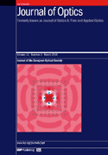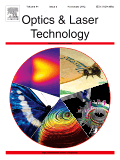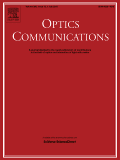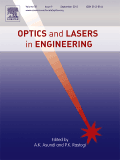
Computer Optics
Scope & Guideline
Connecting Ideas: The Future of Optics and Computer Science
Introduction
Aims and Scopes
- Optical Imaging and Processing:
Research on methods for enhancing, segmenting, and analyzing optical images using various algorithms, including neural networks and traditional image processing techniques. - Machine Learning and AI in Optics:
Application of machine learning and artificial intelligence to improve optical systems, including image classification, object detection, and feature extraction from optical data. - Advanced Optical Materials and Structures:
Exploration of novel optical materials, devices, and structures, such as photonic crystals and metasurfaces, which enhance light manipulation and propagation. - Optical Sensors and Measurement Techniques:
Development of optical sensors and measurement systems for various applications, including environmental monitoring, medical imaging, and industrial inspection. - Quantum and Nonlinear Optics:
Investigation of quantum effects in optical systems, including the study of optical vortices and their applications in communication and information processing. - Optical Communication Systems:
Research on the design and optimization of optical communication systems, focusing on improving data transmission rates and reliability using advanced optical techniques.
Trending and Emerging
- Deep Learning for Optical Applications:
There is a significant increase in research employing deep learning methods for tasks such as image segmentation, classification, and enhancement, demonstrating the growing importance of AI in optics. - Multimodal Data Integration:
Emerging studies focus on integrating data from various modalities (e.g., optical, thermal, hyperspectral) to improve analysis and decision-making processes, indicating a trend towards more holistic approaches in optics. - Real-Time Optical Systems:
Research on developing real-time processing capabilities in optical systems is gaining traction, especially in applications like autonomous vehicles and robotics, where immediate feedback and decision-making are critical. - Optical Metasurfaces and Nanostructures:
The exploration of optical metasurfaces and nanostructures is on the rise, with a focus on their unique properties and applications in advanced optical devices and systems. - Bio-Optics and Medical Imaging:
Increasing attention is being paid to bio-optics and medical imaging techniques, driven by the need for improved diagnostic tools and imaging methods in healthcare.
Declining or Waning
- Traditional Optical Techniques:
There has been a noticeable decline in publications focusing on conventional optical techniques, as research increasingly shifts towards integrating advanced computational methods and machine learning to enhance optical performance. - Basic Image Processing Algorithms:
The focus on fundamental image processing algorithms is waning, as researchers now prefer more sophisticated approaches involving deep learning and AI, which offer better performance in complex image analysis tasks. - Classical Optical Theory Applications:
Studies based solely on classical optical theories, without incorporating modern computational approaches, are becoming less frequent, indicating a trend towards hybrid methodologies that combine traditional optics with advanced computational techniques.
Similar Journals

Journal of Optics
Empowering Discoveries in the World of LightThe Journal of Optics, published by IOP Publishing Ltd, stands as a pivotal platform for disseminating cutting-edge research in the fields of atomic, molecular physics, and optics as well as electronic, optical, and magnetic materials. With an impact factor reflective of its esteemed position—ranking in the 60th percentile in both relevant Scopus categories—this journal, boasting an ISSN of 2040-8978 and an E-ISSN of 2040-8986, is uniquely positioned to foster innovation and collaboration among researchers, professionals, and students worldwide. Located in the United Kingdom and operational since 2010, the journal embraces an open access model, promoting maximal reach and engagement with the latest discoveries that shape the future of optics. As it continues to evolve through its converged years up to 2024, the Journal of Optics remains a critical resource for those seeking to advance their knowledge and influence in this dynamic field.

Biomedical Optics Express
Exploring the Intersection of Light and LifeBiomedical Optics Express, published by the prestigious Optica Publishing Group, is an open-access journal that has been at the forefront of the field of biomedical optics since its inception in 2011. With an ISSN of 2156-7085, this journal has established itself as a premier platform for disseminating high-quality research that spans an array of topics in atomic and molecular physics, optics, and biotechnology. As a testament to its scholarly impact, it is currently ranked in the Q1 category for both Atomic and Molecular Physics and Biotechnology, reflecting its commitment to excellence within these disciplines. The journal features cutting-edge articles that foster innovation and collaboration among researchers, professionals, and students who are passionate about applying optical technologies to solve pressing challenges in medicine and biology. Based in the United States, Biomedical Optics Express continues to shape the future of optical science and its applications, inviting contributions that inspire and drive forward the boundaries of knowledge.

Chinese Optics
Nurturing Excellence in Optical Research and Collaboration.Chinese Optics is a premier journal dedicated to advancing the field of optics, encompassing research on atomic and molecular physics. Published by the esteemed Changchun Institute of Optics Fine Mechanics & Physics in China, this journal supports the sharing of cutting-edge findings since its inception in 2010. With an ISSN of 2097-1842, it operates within a competitive landscape, currently positioned in Q3 of the category for Atomic and Molecular Physics and Optics, according to the 2023 metrics. While the journal is not open access, it offers a valuable platform for researchers, professionals, and students to explore and contribute to significant discoveries in the realm of optics and light technology. By fostering scholarly communication, Chinese Optics plays a crucial role in bridging theoretical and practical aspects, making it an indispensable resource for those passionate about the optical sciences.

Photonics
Fostering Collaboration in Cutting-Edge OpticsPhotonics, an esteemed journal published by MDPI, is a leading platform for researchers in the fields of atomic and molecular physics, optics, and instrumentation. Since its inception in 2014, the journal has fostered open access to cutting-edge research, facilitating knowledge dissemination in these dynamic disciplines. With its Q2 ranking in the 2023 Scopus metrics for various categories, including radiology, nuclear medicine, and imaging, Photonics represents a crucial academic resource for professionals and students seeking to advance their understanding and expertise. Located in Basel, Switzerland, the journal plays a pivotal role in bridging theoretical and practical approaches to photonic technologies. Researchers are encouraged to contribute their findings, thereby enriching the journal’s impact and relevance in the global scientific community through collaboration and innovation.

ACTA OPTICA SINICA
Exploring Breakthroughs in Optical SciencesACTA OPTICA SINICA is a distinguished journal dedicated to the field of optics and photonics, published by the Chinese Laser Press. With an ISSN of 0253-2239, this journal has been an essential resource since its inception, covering significant discoveries and advancements in atomic and molecular physics, electronic materials, and optical sciences. The journal is indexed in Scopus, achieving respectable ranks as Q3 in both Atomic and Molecular Physics, and Optics and Electronic, Optical and Magnetic Materials, reflecting its engagement with current research trends. Although it is not an open-access journal, ACTA OPTICA SINICA is hosted from Shanghai, China, and continues to serve as a vital platform for researchers, professionals, and students alike to disseminate and access high-quality peer-reviewed articles, ensuring its prominent place in the academic discourse related to optics and material sciences.

FIBER AND INTEGRATED OPTICS
Fostering Breakthroughs in Optical TechnologiesFIBER AND INTEGRATED OPTICS is a prominent academic journal published by TAYLOR & FRANCIS INC, focusing on the cutting-edge domains of optical and fiber technologies. Since its inception in 1977, the journal has journeyed through expansive developments in the fields of Atomic and Molecular Physics, as well as Electronic, Optical, and Magnetic Materials, boasting a converged publication history extending to 2024. With a solid reputation reflected in its Q3 rankings in both aforementioned categories, FIBER AND INTEGRATED OPTICS serves as an essential platform for researchers, professionals, and students to disseminate and explore innovative findings and methodologies. Although currently not offering Open Access, its scholarly contributions remain invaluable, fostering a deeper understanding and advancements in fiber optic applications and integrated optical systems. Situated in the United Kingdom, the journal continues to attract a diverse global audience, solidifying its significance in contemporary scientific discourse.

OPTICAL MEMORY AND NEURAL NETWORKS
Exploring the Intersection of Light and IntelligenceOPTICAL MEMORY AND NEURAL NETWORKS is a premier academic journal dedicated to advancing the fields of optical memory technologies and neural network applications. Published by SpringerNature in the United States, this interdisciplinary journal serves as an essential platform for researchers and professionals to disseminate findings and insights that bridge the gap between computer science, electrical engineering, and materials science. With an ISSN of 1060-992X and an E-ISSN of 1934-7898, it encompasses a wide range of innovative topics across its scope, which includes but is not limited to optical storage methods, neural network modelling, and the interaction of light with electronic materials. Though currently categorized in the Q4 tier across multiple relevant disciplines—such as computer science and electrical engineering—its commitment to quality research aims to enhance its standing in the academic community by 2024. Through rigorous peer review and an emphasis on novel contributions, this journal not only encourages exploration and development in emerging areas of technology but also seeks to support the educational needs of students and practitioners alike, fostering a collaborative environment for scientific advancement.

OPTICS AND LASER TECHNOLOGY
Cutting-edge Research for a Brighter TomorrowOPTICS AND LASER TECHNOLOGY, published by Elsevier Science Ltd, is a premier journal dedicated to advancing knowledge in the fields of optics and laser applications. With its impressive Q1 rankings across three critical categories—Atomic and Molecular Physics, and Optics; Electrical and Electronic Engineering; and Electronic, Optical and Magnetic Materials—the journal stands at the forefront of scientific discourse, boasting a significant impact factor that underscores its relevance. Since its inception in 1970, the journal has consistently provided a platform for the dissemination of cutting-edge research, key innovations, and reviews that influence both academic study and practical applications. Although it currently does not have open access options, its rigorous peer-review process and inclusion in esteemed indexing services make it a valuable resource for researchers, professionals, and students seeking to stay informed about the latest developments in optics and laser technology. The journal’s ongoing commitment to quality research ensures it remains a vital publication for those engaged in this dynamic field, with a converged projection extending through 2025.

OPTICS COMMUNICATIONS
Unveiling Breakthroughs in Optical ScienceOptics Communications, published by Elsevier, is a prestigious international journal that focuses on the dynamically evolving fields of optics and photonics. With its ISSN 0030-4018 and E-ISSN 1873-0310, this journal has made significant contributions to the fields of Atomic and Molecular Physics, Electrical and Electronic Engineering, Electronic, Optical and Magnetic Materials, and Physical and Theoretical Chemistry, consistently ranking in the Q2 quartile across these categories for 2023. The journal, based in the Netherlands, is recognized for its rigorous peer-review process and aims to publish high-quality research articles that advance knowledge and applications in optical communication technologies. Although it operates under a subscription model, the insightful research published here plays an essential role in informing the work of researchers, professionals, and students alike. With a history dating back to 1969 and spanning well into 2025, Optics Communications remains a crucial resource for cutting-edge developments in optics, catering to a global audience dedicated to innovation in this pivotal science.

OPTICS AND LASERS IN ENGINEERING
Advancing the Frontiers of Optical EngineeringOPTICS AND LASERS IN ENGINEERING, published by Elsevier Science Ltd, is a premier journal dedicated to advancing the field of optics and laser technology in engineering applications. With a robust ISSN of 0143-8166 and E-ISSN 1873-0302, this journal is positioned within the top quartile (Q1) across several categories, including Atomic and Molecular Physics, Electrical Engineering, and Mechanical Engineering as of 2023, showcasing its prestige and impact in the scientific community. The journal has consistently ranked high in Scopus, notably within the top 10% for Mechanical Engineering and Electronic, Optical, and Magnetic Materials research. Since its inception in 1980, OPTICS AND LASERS IN ENGINEERING has served as a vital platform for disseminating cutting-edge research, fostering innovation and collaboration among researchers, professionals, and academia. Though it does not currently offer Open Access options, its high impact factor and selective publication process ensure that articles reach a wide audience while maintaining rigorous academic standards. Researchers and students alike are encouraged to engage with this influential journal to contribute to and stay abreast of advancements in optical technologies and their engineering applications.